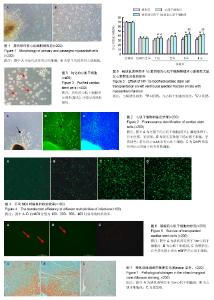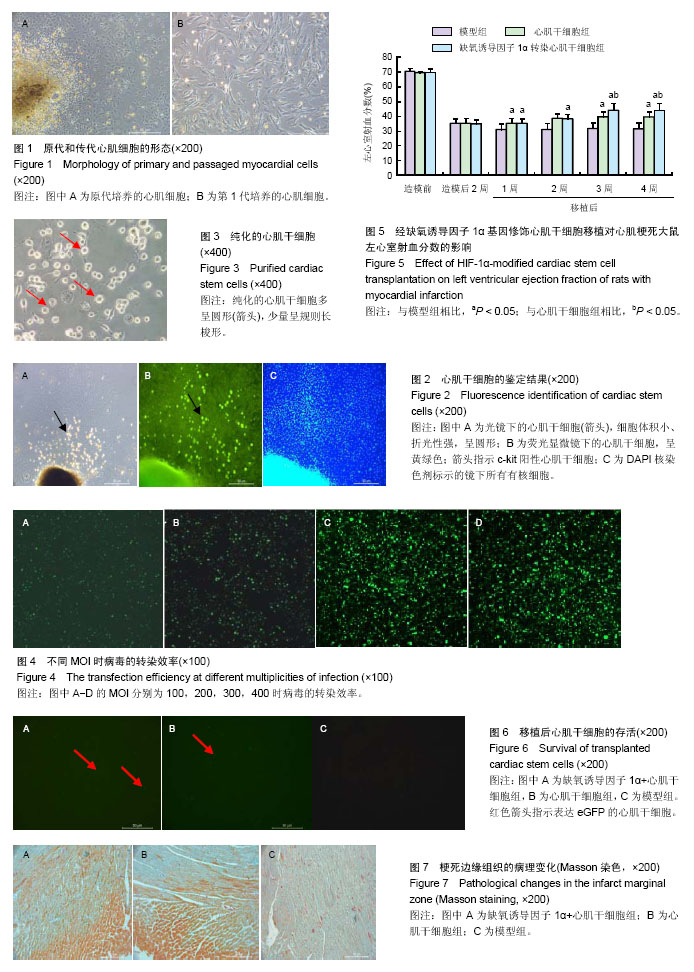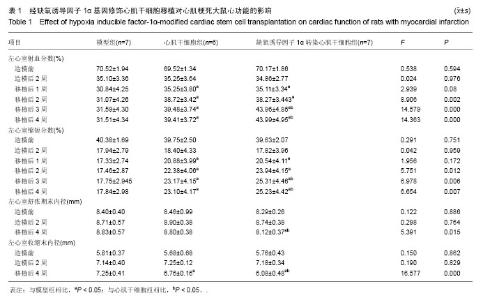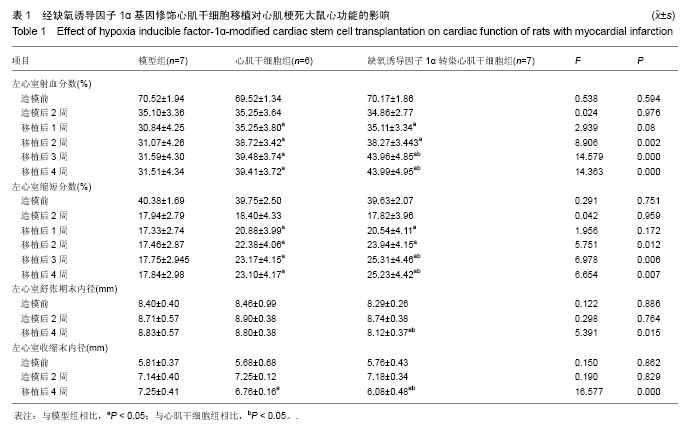| [1] Beltrami AP, Barlucchi L, Torella D, et al. Adult cardiac stem cells are multipotent and support myocardial regeneration. Cell. 2003;114(6):763-776.[2] Doppler SA, Deutsch MA, Lange R, et al. Cardiac regeneration: current therapies-future concepts. J Thorac Dis. 2013;5(5):683-697. [3] Tal R. The role of hypoxia and hypoxia-inducible factor-1alpha in preeclampsia pathogenesis. Biol Reprod. 2012;87(6):134. [4] Hinkel R, Lebherz C, Fydanaki M, et al. Angiogenetic potential of Ad2/Hif-1α/VP16 after regional application in a preclinical pig model of chronic ischemia. Curr Vasc Pharmacol. 2013;11(1):29-37.[5] 王曼.经Bcl-2修饰的同种异体骨髓间充质干细胞移植对兔心梗后心功能不全的影响[D].石家庄:河北医科大学,2014.[6] 胡炜,李树仁,张素巧,等.自体骨髓间充质干细胞移植对心肌梗死后兔Ryanodine受体及其稳定蛋白表达的影响[J].中国老年学杂志,2012,32(1):110-113. [7] 乔建晶,李树仁,胡炜,等.自体骨髓间充质干细胞移植对心肌梗死后心衰家兔炎性因子表达的影响[J].中国老年学杂志,2011, 31(11):2048-2051. [8] Lloyd-Jones D, Adams R, Carnethon M, et al. Heart disease and stroke statistics--2009 update: a report from the American Heart Association Statistics Committee and Stroke Statistics Subcommittee. Circulation. 2009;119(3):480-486.[9] Hoover-Plow J, Gong Y. Challenges for heart disease stem cell therapy. Vasc Health Risk Manag. 2012;8:99-113.[10] Quijada P, Toko H, Fischer KM, et al. Preservation of myocardial structure is enhanced by pim-1 engineering of bone marrow cells. Circ Res. 2012;111(1):77-86.[11] 王曼,李树仁.基因工程在骨髓间充质干细胞治疗心肌梗死中的应用[J].中国老年学杂志,2015,35(1):269-271.[12] Ahluwalia A, Tarnawski AS. Critical role of hypoxia sensor--HIF-1α in VEGF gene activation. Implications for angiogenesis and tissue injury healing. Curr Med Chem. 2012;19(1):90-97.[13] Xu Y, Zuo Y, Zhang H, et al. Induction of SENP1 in endothelial cells contributes to hypoxia-driven VEGF expression and angiogenesis. J Biol Chem. 2010;285(47):36682-36688. [14] Semenza GL. Regulation of metabolism by hypoxia-inducible factor 1. Cold Spring Harb Symp Quant Biol. 2011;76: 347-353.[15] Le Moine CM, Morash AJ, McClelland GB. Changes in HIF-1α protein, pyruvate dehydrogenase phosphorylation, and activity with exercise in acute and chronic hypoxia. Am J Physiol Regul Integr Comp Physiol. 2011;301(4):R1098-1104. [16] 周启璠,于淼,陈国良,等.缺氧诱导因子-1及其抑制剂的研究进展[J].中国药物化学杂志,2014,24(1):48-58.[17] Chu W, Li X, Li C, et al. TGFBR3, a potential negative regulator of TGF-β signaling, protects cardiac fibroblasts from hypoxia-induced apoptosis. J Cell Physiol. 2011;226(10): 2586-2594. [18] Zhang Q, Qian Z, Pan L, et al. Hypoxia-inducible factor 1 mediates the anti-apoptosis of berberine in neurons during hypoxia/ischemia. Acta Physiol Hung. 2012;99(3):311-323. [19] Yang B, He K, Zheng F, et al. Over-expression of hypoxia-inducible factor-1 alpha in vitro protects the cardiac fibroblasts from hypoxia-induced apoptosis. J Cardiovasc Med (Hagerstown). 2014;15(7):579-586.[20] 李红乐,邢飞跃,孙学刚,等.腺病毒介导的EGFP基因在大鼠骨髓间充质干细胞中高效表达[J].中国病理生理杂志,2003,19(3): 293-296.[21] 康健,侯洋,周许辉,等.TGF-β3和BMP-7腺病毒共转染兔骨髓间充质干细胞向类髓核细胞分化的研究[J].中国脊柱脊髓杂志, 2014(2):68-74.[22] 周青,郭瑞强,陈新,等.经胸超声心动图对3种兔心力衰竭模型的检测[J].中国超声医学杂志,2005,21(5):325-327.[23] Xu HX, Li GS, Jiang H, et al. Implantation of BM cells transfected with phVEGF165 enhances functional improvement of the infarcted heart. Cytotherapy. 2004;6(3): 204-211.[24] Sato Y, Yamada T, Taniguchi R, et al. Persistently increased serum concentrations of cardiac troponin t in patients with idiopathic dilated cardiomyopathy are predictive of adverse outcomes. Circulation. 2001;103(3):369-374.[25] Dispenzieri A, Kyle RA, Gertz MA, et al. Survival in patients with primary systemic amyloidosis and raised serum cardiac troponins. Lancet. 2003;361(9371):1787-1789.[26] 刘路平,谢晓林,林玎.联合cTnT?hs-CRP?NT-ProBNP 测定对心力衰竭的诊断及预后判断的意义[J].心脑血管病防治,2011, 11(1):87. [27] Hudson MP, O'Connor CM, Gattis WA, et al. Implications of elevated cardiac troponin T in ambulatory patients with heart failure: a prospective analysis. Am Heart J. 2004;147(3): 546-552. [28] Niizeki T, Takeishi Y, Arimoto T, et al. Heart-type fatty acid-binding protein is more sensitive than troponin T to detect the ongoing myocardial damage in chronic heart failure patients. J Card Fail. 2007;13(2):120-127. [29] Miettinen KH, Eriksson S, Magga J, et al. Clinical significance of troponin I efflux and troponin autoantibodies in patients with dilated cardiomyopathy. J Card Fail. 2008;14(6):481-488.[30] 葛均波,黄浙勇.干细胞治疗急性心肌梗死:离临床应用还有多远?[J].中国实用内科杂志,2011,31(10):739-742. |



